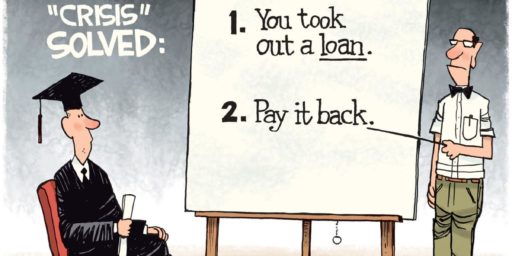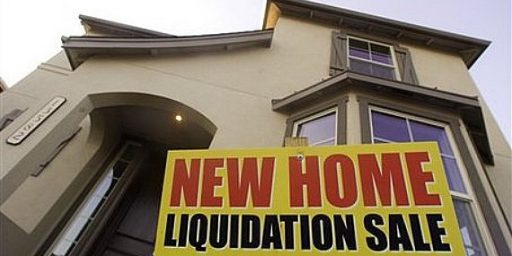Government Ownership of Banks
I heard on the radio this morning that the Treasurey Department is thinking of adopting the British rescue plan of recapitalizing banks by purchasing a majority of the shares in banks that opt into the rescue plan. Now keep in mind this is completely unconfirmed because at this point I can’t find any articles anywhere that back this story up. However, such a move is probably a really, really bad idea.
Part of the problem with the financial industry over that last 30 years or so has been the politicization of home loans. Getting people who don’t have the 20% down payment for a home loan into homes with less than the 20%, no down payment at all, and even people who have no credit and even bad credit. The last one in particular is extremely foolish. These are people with a proven track record on not being reliable in paying bills and you are going to give them a loan that could be for several hundred thousand dollars and think that the risk is going to disappear simply because the way multiple mortgages are bundled together?
Now some will say that sub-prime loans under things like the CRA were really not the root cause of the problem. I don’t think there was a simple single cause, and I think defenders of the CRA are a bit disingenuous when they make arguments defending the CRA. For example defenders will argue that CRA was enacted in 1977 with little or no problems for the next 20 years. True enough, but CRA now is not the same as CRA in 1977, just as Medicare now is not the same as Medicare in the 1960s. To pretend otherwise is intellectually dishonest. According to Wikipedia the CRA was changed in 1989, 1992, 1994, 1995, 1999 and 2005. So when people like Ellen Seidman tells us “the timing is all wrong since CRA was first passed in 1977,” she is being deceptive at the very least. For example, under the CRA entry at Wikipedia we have this,
In October 1997, First Union Capital Markets and Bear, Stearns & Co launched the first publicly available securitization of Community Reinvestment Act loans, issuing $384.6 million of such securities. The securities were guaranteed by Freddie Mac and had an implied “AAA” rating.[18][19] The public offering was several times oversubscribed, predominantly by money managers and insurance companies who were not buying them for CRA credit.
In October 2000, in order to expand the secondary market for affordable community-based mortgages and to increase liquidity for CRA-eligible loans, Fannie Mae committed to purchase and securitize $2 billion of “MyCommunityMortgage” loans.[21][22] In November 2000 Fannie Mae announced that the Department of Housing and Urban Development (“HUD”) would soon require it to dedicate 50% of its business to low- and moderate-income families.” It stated that since 1997 Fannie Mae had done nearly $7 billion in CRA business with depository institutions, but its goal was $20 billion.[19] In 2001 Fannie Mae announced that it had acquired $10 billion in specially-targeted Community Reinvestment Act (CRA) loans more than one and a half years ahead of schedule, and announced its goal to finance over $500 billion in CRA business by 2010, about one third of loans anticipated to be financed by Fannie Mae during that period.[23]
Under the 1995 change to the legislation we get this,
According to a 2000 United States Department of the Treasury study of lending trends in 305 U.S. cities between 1993 and 1998, $467 billion in mortgage credit flowed from CRA-covered lenders to low- and medium-income borrowers and areas. In that period, the total number of loans to poorer Americans by CRA-eligible institutions rose by 39% while loans to wealthier individuals by CRA-covered institutions rose by 17%. The share of total US lending to low and meduim income borrowers rose from 25% in 1993 to 28% in 1998 as a consequence.
In short, over the years there was a concentrated push to expand the number of low income/riskier types of borrowers who were covered under CRA. To claim that the timing is all wrong is just not true. CRA was the umbrella under which all of these changes took place.
Now, the problem here is that government has gotten involved in the home loan market with an eye towards subsidizing home ownership for those who are low income and/or higher risk. And instead of doing it in a straight forward manner–i.e. giving such borrowers the 20% needed for the down payment they forced banks to make loans that they otherwise would not have made. Banks and Wall Street firms tried to mitigate the risks with MSBs but in reality it hid the risks (and Fannie Mae and Freddie Mac were very much involved with this too), and with housing prices rising many people saw it as an opportunity to get rich.
Some might wonder, but it was just a house of cards how could people fall for it. The same way they fall for pyramid schemes, 419 scams and so forth. They are greedy and either figure they can get out before the bubble bursts or that they are special and wont get scammed. The problem is that in this case it was a huge house of cards and so much of the rest of the economy stands to be adversely impacted by the mess.
But the bottom line is that politicians have different objectives than bankers. Politicians crave power that their elected office conveys on them. Bankers on the other hand are concerned about profits, the soundness of the bank, share holder value and his own paycheck. The politician realizes that he can secure his hold on power by tossing pork and other goodies to his constituents. The banker realizes that one way to improve profits, soundness of the bank, shareholder value and his own paycheck is to not lend to borrowers who are too risky. And this is where we have a potential problem. If the politician decides to try and toss some home loan pork to his constituents then you could have a bank that is lending to riskier borrowers and you risk the health of the bank. Do that enough and soon you could have problem in the entire banking industry.
This shouldn’t be shocking nor should it be controversial. We’ve seen what happens when politicians/government takes control of allocating resources. Was the Soviet Union a great place to live where they couldn’t even produce enough toilet paper? In the first half of this century millions starved due to crappy central planning. Look at North Korea, China, and Cuba. Not exactly countries noted for their high standards of living. And in the case of China one reason why they’ve had some measure of economic success is because they’ve gone in the opposite direction–i.e. more market oriented reforms.
Having the government take a majority ownership stake in U.S. banks would be a bad idea. It would not address the problem that led to this crisis: government involvement in the home loan industry.






I admit that a lot of the nitty gritty details with regards to how the whole finance system works are something I do not fully understand. However my gut tells me that government ownership in part or whole is not a good thing.
I really wish instead of rushing out to hand banks a bunch of money to “save” them, we would really take the time to look at where the mess went wrong, and to get rid of the regulative steps that were a definite problem, enforce the regulations that do help, and do whatever with the neutral ones.
But it seems that doing the wrong thing right now would be a bad move and doing too much is a major over reaction.
Keep in mind that they do have some precedent for doing something like this, in Japan (where they finally injected money into the finance sector after 8 years of doing nothing but lowering interest rates and spending ungodly amounts of money on public works projects). It helped, at least until Japan ran into this particular crisis.
Aside from that, I’ve always wondered that about government financing programs. If they wanted to help low-income homeowners, then why not just lend them the down payment and closing costs’ money at a very low-interest rate? That doesn’t help those with bad credit, but perhaps you could help them with getting the deposit for renting.
In the Netherlands we have the NHG (national mortgage fund), to help lower income earners buy their own house (the link explains how it works).
In 2001 we had about 650 foreclosures and about 9% had to use the guarantee because they had to sell their house at a loss. In 2007 we had 935 foreclosures and allready 140 who needed the guarantee because they had to sell their house at a loss. (16 million inhabitants, about half owns a house)
Our rules were rather strict, about how high the mortgage could be compared to your income. But due to privatization we had more foreign players offering mortgages (bank of Scotland, Lehmans) that were riscier. Since one of the conditions to get the NHG was that the interest should be fixed for more than 5 years and this started around 2003 we will have more foreclosures the coming years. That’s not due to government influence, au contraire, that is due to privatization and lack of oversight/bad creditmanagement.
Our situation is not entirely comparable. We have better financial stability for most people and we have had a housing shortage since WW2. But we also have higher mortgages than people in most other countries. Still, the number of people in trouble will be relatively small and our biggest problem isn’t our home market.
If the government’s going to get into the banking business, why doesn’t it just get into the banking business instead of dragging all of the baggage from these failed institutions behind it? $2 trillion of capitalization should get it started. Obviously, if it needs more, they have more.
Better yet, just dump the Federal Reserve Notes and start printing Treasury Notes. They surely would be worth more.
Not that this credit based economy has been over extended, if you give the banks money and the banks loan it to businesses, who are the businesses going to sell their products and services to?
The Cause
That doesn’t help those with bad credit, but perhaps you could help them with getting the deposit for renting.
Actually they do have that through section 8, of course you have to follow certain rule to keep it and a lot of slum lords won’t take it, because they do not want to deal with the paperwork.
I do think there is also a difference between low income and bad credit. Seems to me taking a risk on a low income person with good credit is likely worth it, but requiring banks to float loans or even banks taking on loans for people with bad credit seems a little risky.
I do think the VA has a rather successful home loan insurance program. We used the VA loan system with two home purchases (we had about 5 years of renting and we qualified at that point again for the VA program). It has some very strict income/debt ratio-but I don’t remember now what it was. I do know it was rather strict. They also had very strict rules about the type of property it would insure-the only one I remember off hand is that all stairs had to have a railing, because the first home we purchased had two steps off the front porch with no railing and the own had to install one for us to qualify for the loan.
Ideally there’d be no bail out at all – it should be private enterprise whether you’re making money or losing it. But if the gov’t is going to get involved and do a bail out, buying stocks isn’t a bad way to go about it … at least the taxpayer has something for his dollar then.
When the economy improves the banks can and should buy back their shares – that way the gov’t is only in the banking business so long as the banks need gov’t help.
“The banker realizes that one way to improve profits, soundness of the bank, shareholder value and his own paycheck is to not lend to borrowers who are too risky.”
This is so 1960s.
Your argument hinges on an outdated model that mortgages lenders retained the credit exposure. They don’t, or at least very many of them didn’t whilst the securitization freight train was hurtling down the tracks over the last 5-10 years when mortgage lending ballooned.
I am also very unimpressed at the general argument that government policy led to the explosion in subprime lending specifically and the housing bubble generally.
Why? Because nobody has produced a scrap of evidence that:
(a) regulated institutions (who are required to comply with the CRA) provided the a significant proportion of subprime loans. Unless they did, there is little evidence that this was instrumental in fuelling the housing bubble.
(b) most subprime lending was advanced toward low-income borrowers. Subprime and Alt-A products were heavily used by speculators in the housing market. What was the split between Hard-up Joes and Flash Tonys?
I’d be interested to see such data produced…
Oh look, here’s something from 2004.
Doing the maths, the top five subprime lenders from 2003 – see any banks in there? – account for over one third of the subprime market.
So when you write – “CRA was the umbrella under which all of these changes took place” – I call bullshit on this. This is laughably inaccurate. The market liked, actually loved, subprime when the economy was growing and the housing market was booming, because defaults were both rare and virtually costless.
Not so much after the bust, obviously.
As someone who works for a firm that went balls and all into the subprime game, I know firsthand that most of our dialog with regulators was us arguing that the rates on products we were funding were not predatory. Kowtowing to government missives to lend to poorer people is simply not something that entered the equation.
Hope this doesn’t come as a shock that private industry behaves this way.
Oh yeah, and having the government invest in banks is not about addressing the causes of the housing boom and bust; it is about preventing a collapse of the financial system. You did know that, right?
Here we go again: Politician=Bad, Banker=Good. More than just a little simplistic, Steve.
For starters, do you really think these bankers had nothing to do with the writing of the various changes to the CRA? The 2 FMs time and again fought back (successfully) against legislation to require them to increase their capitalization. This is something that would have cut into their short term profits, but would have increased their long term strength.
I can go along with this statement, tho I would have said, “one way he can secure his hold on office…”, and added, “to the various business and financial institutions who fund their campaigns.”
and yes, that would be one way to do it, but it was not the way they chose to do it. And yes, they did choose to lend to risky borrowers. I am not talking about home loans here (that mess is well beyond my limited comprehension), but rather credit cards. What does one call marketing high interest credit cards (with teaser rates) to college students with no credit rating and no job? Predatory?
When I first heard of sub-prime lending and these credit cards, I remember thinking, “What the F?” One did not have to be a finance whiz, or an ace economist to see this was a house of cards. I kept thinking, “There is way too much money out there.”
I think now, I was wrong. The money wasn’t out there. And that was the real problem.
ps: if these high powered execs were so concerned about “share holder value” they would all willingly give up their golden parachutes, wouldn’t they? My bet is, they won’t with out a fight.